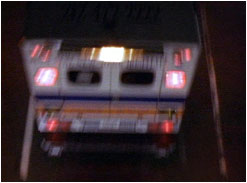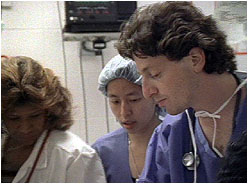The Journey Begins | Dear Film Crew: Help! | On Call | Alex's Case
Over the next couple of weeks, we will be following Dr. Jamshid Ghajar,
the neurosurgeon who saved the life of the Central Park patient, as he
encounters new severe head trauma cases. Dr. Ghajar is one of a group of
neurosurgeons trying to revolutionize the treatment of coma patients. He
 believes that the Central Park patient survived because of treatment
methods that he and a small group of neurosurgeons are trying to bring to
the attention of the entire medical community. In some cases, these
methods fly in the face of conventional medical wisdom. We are catching
this field in the midst of a revolution.
believes that the Central Park patient survived because of treatment
methods that he and a small group of neurosurgeons are trying to bring to
the attention of the entire medical community. In some cases, these
methods fly in the face of conventional medical wisdom. We are catching
this field in the midst of a revolution.
At 6:00 a.m. this Thursday, August 22nd, Dr. Ghajar goes 'on call.' This
means that if a severe head trauma case arrives at either Jamaica Hospital
in the Queens or New York Hospital-Cornell Medical Center on the Upper East
Side, Dr. G will be the attending physician called.
After discussing the case and reviewing CT scans sent by computer to his
home or office, Dr. G will decide whether he needs to intervene. If so, he
will walk to New York Hospital from his home or office, or he will drive to
Jamaica. The walk takes about 10 minutes; the drive takes about a half
hour. At the hospital, Dr. G will evaluate the patient's level of response
on the Glasgow Coma Scale (for example, if the patient obeys commands,
he/she get 6 points for motor response, but if the patient can only respond
to a painful stimuli by abnormal extension of his/her body, the patient
scores only 2 points); Dr. G might insert a ventricular catheter to relieve
and monitor pressure; he might order new CT scans; he might transfer the
patient to the ICU; he might discover a blood mass on the CT scans and
transfer the patient to the OR for brain surgery. Or he might go back
home. He will be on call, 24 hours a day, until 6 a.m. on Thursday,
September 5th.
Jamaica Hospital receives far more head trauma cases than New York
Hospital—about 2 cases a week that go as far as surgery during 'head
trauma season,' which is usually spring and summer (March through
September). This summer has been quieter than usual, so far, because of
the weather: It's been cooler than average, with no real heat waves
(hotter, sunnier days bring more head traumas; cool or rainy days are
quiet). Weekends are usually busier than mid-week, and holiday weekends
(such as Labor Day) are usually busier than other weekends.
Having said all of that, we could get a case on a Tuesday afternoon at New
York Hospital.
To maximize our chances of capturing a case from early on (from the moment
it arrives at the hospital), we have some unusual logistics to reckon
with—namely, the team will be split between the two hospitals, and will
come together only when we have a case.
If Team 1 gets a case at Jamaica, Team 2 will travel to Jamaica with Dr.
Ghajar, who parks his car near Team 2's post. If Team 2 gets a case, Team
1 will drive to New York Hospital in the production van, which will be
 stationed at Jamaica Hospital. If either team gets a case, the production
assistant will get beeped and also join us, driving to the location in his
car.
stationed at Jamaica Hospital. If either team gets a case, the production
assistant will get beeped and also join us, driving to the location in his
car.
Once we are manning our battle stations, we each face the biggest
challenge: working with round-the-clock shifts of trauma dispatchers to
teach them to filter cases and alert us. As it stands now, the best that
the hospitals can do is to provide universal trauma alert, but this would
exhaust us all by the end of 24 hours. We'd be responding to cases that
didn't even involve head traumas, or to minor bumps on the head that
wouldn't involve Dr. G. So each team must spend the first couple of days,
taking turns linking up with the beginning of each new shift of dispatchers
(there are three 8-hour shifts, I believe). The dispatchers have been
alerted about our project, but it's up to us to fine-tune their task.
Specifically, we want them to alert us to cases involving severe head
trauma, using our beeper system, rather than their generic trauma beepers.
We may want to specify loss of consciousness. We don't want to be called
if someone merely has a concussion.
Once our systems are in place, there could very well be days and days of
waiting—then, in a split second, we could be cranking through the night on
some pretty intense case.
While we are waiting, neither Team can physically drift far from their
stations. Each hospital says that it can have as little as three minutes
to prepare for an incoming case—and that their own trauma teams sometimes
have trouble assembling so quickly! Each of us will be learning, as the
shoot unfolds, how to dress, assemble equipment, and fly down flights of
stairs, to respond to cases.
As I'm sure you realize, both hospitals are concerned that we not, for a
picosecond, get in the way of patient care. Jamaica would prefer that we
hang out in the ER for the first couple of days to get a feel for their ER
frenzy.
Some requests that I know will be obvious but that both hospitals want me
to pass along to you: Never block a doorway. Please be careful with the
lines for oxygen and the cables to monitors. These will block your
circulation around a patient, but they cannot be tampered with; don't ever
 move into a position around a patient in the ER without looking at your
circulation path first. Don't get in the way of the teams. They're not
just concerned about our bodies getting in the way; they're concerned about
booms smacking people in the face. Eight to 10 people can surround a
patient at any given moment in the ER. How we go about making this film is
a bit of an experiment. We will all give it our best for the first several
days, and I have no doubt that we'll discover a lot in the process. We may
discover that splitting the teams is thinning our resources too much—and
that we need to find a way to put all our eggs into the Jamaica Hospital
basket, especially if cases keep popping up there. Then we'll just need
to deal with housing, since Jamaica has only two rooms. We can double up
in an emergency (there's a couch and a bed in each room), but if we're all
going to assemble at Jamaica for the long haul, we'll have to rent a
Winnebago or something. Oh the stories you'll all have to tell!"
move into a position around a patient in the ER without looking at your
circulation path first. Don't get in the way of the teams. They're not
just concerned about our bodies getting in the way; they're concerned about
booms smacking people in the face. Eight to 10 people can surround a
patient at any given moment in the ER. How we go about making this film is
a bit of an experiment. We will all give it our best for the first several
days, and I have no doubt that we'll discover a lot in the process. We may
discover that splitting the teams is thinning our resources too much—and
that we need to find a way to put all our eggs into the Jamaica Hospital
basket, especially if cases keep popping up there. Then we'll just need
to deal with housing, since Jamaica has only two rooms. We can double up
in an emergency (there's a couch and a bed in each room), but if we're all
going to assemble at Jamaica for the long haul, we'll have to rent a
Winnebago or something. Oh the stories you'll all have to tell!"
In between paragraphs I fidget with my trusty Swingline Stapler (no, it's
not the same one that I had when I was in the second grade). I realize
that I don't understand how the contraption works. You put a whole bar of
U-shaped metal pieces into the easy-loading device. But then you have to
close the top. When you clamp down on papers to staple, there's no real
way of seeing exactly how the U-shaped piece of metal becomes folded and
flattened. It's not magic, but it's hidden from view.
That's precisely what this stage in a documentary project is like. All
you can do is properly load all the elements. But then you have to shut
the top, and take a leap of faith that it's going to come together.
Sometimes it doesn't.
The Journey Begins | Dear Film Crew: Help! | On Call | Alex's Case
Photos: (1-3) NOVA/WGBH Educational Foundation.

 believes that the Central Park patient survived because of treatment
methods that he and a small group of neurosurgeons are trying to bring to
the attention of the entire medical community. In some cases, these
methods fly in the face of conventional medical wisdom. We are catching
this field in the midst of a revolution.
believes that the Central Park patient survived because of treatment
methods that he and a small group of neurosurgeons are trying to bring to
the attention of the entire medical community. In some cases, these
methods fly in the face of conventional medical wisdom. We are catching
this field in the midst of a revolution.
 stationed at Jamaica Hospital. If either team gets a case, the production
assistant will get beeped and also join us, driving to the location in his
car.
stationed at Jamaica Hospital. If either team gets a case, the production
assistant will get beeped and also join us, driving to the location in his
car.
 move into a position around a patient in the ER without looking at your
circulation path first. Don't get in the way of the teams. They're not
just concerned about our bodies getting in the way; they're concerned about
booms smacking people in the face. Eight to 10 people can surround a
patient at any given moment in the ER. How we go about making this film is
a bit of an experiment. We will all give it our best for the first several
days, and I have no doubt that we'll discover a lot in the process. We may
discover that splitting the teams is thinning our resources too much—and
that we need to find a way to put all our eggs into the Jamaica Hospital
basket, especially if cases keep popping up there. Then we'll just need
to deal with housing, since Jamaica has only two rooms. We can double up
in an emergency (there's a couch and a bed in each room), but if we're all
going to assemble at Jamaica for the long haul, we'll have to rent a
Winnebago or something. Oh the stories you'll all have to tell!"
move into a position around a patient in the ER without looking at your
circulation path first. Don't get in the way of the teams. They're not
just concerned about our bodies getting in the way; they're concerned about
booms smacking people in the face. Eight to 10 people can surround a
patient at any given moment in the ER. How we go about making this film is
a bit of an experiment. We will all give it our best for the first several
days, and I have no doubt that we'll discover a lot in the process. We may
discover that splitting the teams is thinning our resources too much—and
that we need to find a way to put all our eggs into the Jamaica Hospital
basket, especially if cases keep popping up there. Then we'll just need
to deal with housing, since Jamaica has only two rooms. We can double up
in an emergency (there's a couch and a bed in each room), but if we're all
going to assemble at Jamaica for the long haul, we'll have to rent a
Winnebago or something. Oh the stories you'll all have to tell!"